Bringing home a new puppy can be a time of total joy! But puppies also bring a lot of stress with them.
These little furballs can go from cute to crazy-making faster than you can say Pug – and your current dog probably agrees!
It’s not uncommon for owners to realize that their dog is jealous of the new puppy. What to do?
Let’s talk about how to build harmony in your home – new puppy, older dog, and all.
What Does Jealousy Mean in Dogs, Anyway?
When people call or email me asking about how to fix their dog’s jealousy, my first question is always to ask:
“When you say your dog is being jealous, what does that look like? Pretend I’ve never seen a dog before in my life and describe it to me in as much detail as you can.”
I ask that because jealousy is poorly defined in dogs.
Many scientists and trainers don’t believe that dogs are capable of feeling the complex emotions that we call “jealousy,” though we’ve all seen dogs act in a way that sure looks like jealousy. The actual science is rapidly changing, so it’s just hard to say!
When people say their dogs are being jealous, they often mean that their dog:
- Gets between the puppy and the owner (called splitting).
- Growls at the puppy when they get too close.
- Gives the puppy the stink-eye if they get too close.
- Growls, snarls, snaps, or stares the puppy around resting places.
- Asks for extra petting after a puppy joins the house.
To really be considered jealousy, we should only see these behaviors directed towards another dog in the presence of a person or treasured item.
A 2014 study titled Jealousy in Dogs reports:
“We found that dogs exhibited significantly more jealous behaviors (e.g., snapping, getting between the owner and object, pushing/touching the object/owner) when their owners displayed affectionate behaviors towards what appeared to be another dog as compared to nonsocial objects.”
In other words, the dogs were more likely to act in a way we’d call jealous when the owners were paying attention to another dog, versus when the owner paid attention to an inanimate object.
These dogs might not be feeling jealousy the same way we do, but it sure looks similar.
This won’t surprise you if you’ve watched your dog wiggle between you and another canine, or even get a bit snarkier with some growling or snapping.
The exact behavior(s) that you’re calling jealousy matter, though! It’s one thing if your dog is just following you around asking for extra pats – and quite another if your dog is growling, snarling, or snapping at the new puppy.
Jealousy vs Resource Guarding
Trainers (like myself) get a bit nervous about the term jealousy because the term downplays the serious issue of resource guarding.
Resource guarding is a serious problem where your dog reacts aggressively towards perceived or real threats to her access to an object (like her food bowl, toys, or your lap).
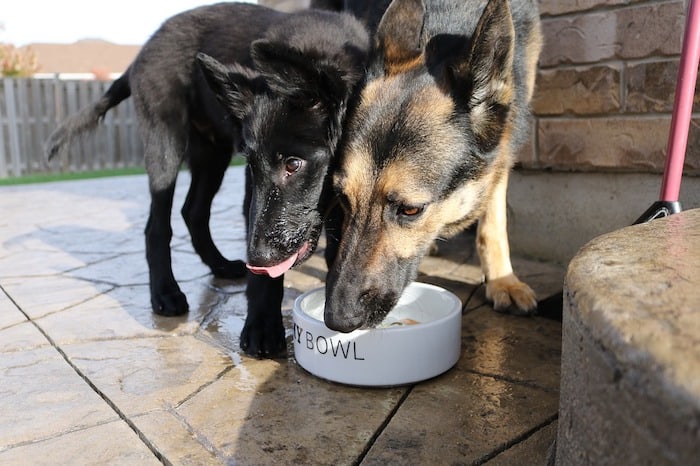
If your dog is “acting jealous,” she is probably guarding resources. The two are closely related, and it’s hard to draw a line in the sand separating them.
Is My Dog’s Jealousy a Form of Dominance?
The second most common label that I hear when dogs are uncomfortable with puppies is dominance.
Most owners are convinced that when an older dog growls at the puppy, it’s because the adult is asserting her alpha status. If the adult dog gets between the owner and the puppy, the adult showing dominance…
Right?
In some ways, this might not be far off.
Dominance is best defined by E.O. Wilson in Sociobiology: The New Synthesis as:
“The assertion of one member of a group over another in acquiring access to a piece of food, a mate, a place to display, a sleeping site or any other requisite that adds to the genetic fitness of the dominant individual.”
To break that down a bit, dominance is essentially the relationship between two individuals and a resource – it’s not a personality trait. It’s really not a huge social factor in dogs because they don’t naturally live in strict packs with a single dominant pair.
While your dog might be generally outgoing, playful, or energetic as a personality trait, dominance isn’t a permanent personality trait.

Many people, including the TV dog trainer Cesar Millan, expand the definition of the word “dominant” up into a catch-all reason for all behavior problems. He (and others) consider dominance and “being alpha” to be the root of behavior problems such as refusing to get in the car, pulling on the leash, or snarling at the owner.
The problem is that when you blame your dog’s behavior on this misconstrued version of dominance, pack theory, or being alpha, it’s very easy to get sucked into violent and scary training tactics that are meant to “put your dog in his place.”
Not only is the scientific reality far from what Milan and others call “dominance,” but there’s an ethical issue with how dominance theory leads us to behave towards our dogs.
Dominance is situation-dependent, pair-dependent, and item-dependent – it’s not a unilateral relationship.
For example, my own dog will readily yield his toys to most other dogs, but will not give up food. That changes based on how stressed he is, who the other dog is, how hungry he is, and many other factors.
There’s also a difference between keeping a resource and taking a resource from another dog. My own dog will growl to keep dogs away from his food bowl, but won’t come steal from other dogs. If his resource guarding was truly dominance-based, we wouldn’t expect so much variety in his response!
Calling a dog dominant doesn’t tell us much about the dog. You might be misreading the situation, and “dominant” means different things to different people. Focus on what you see, not how you interpret it.
Is Your Dog Showing Dominance, Or Is He Just Insecure?
All of that said, dominance isn’t usually the best framework to view behavior problems. It might be part of what’s going on (especially in dog-dog resource guarding cases, aka “jealousy”), but it doesn’t tell the owners much that’s useful.
It’s more likely that your dog is growling at your puppy because he’s insecure than because he’s dominant. Dominant, confident dogs aren’t threatened by little baby puppies – just like confident adult men aren’t threatened by toddlers.
Part of the reason that we want to avoid calling your dog dominant is that this suggests that your job is to “put your dog in his place.”
When you think your dog is dominant, you’re more likely to use correction-based training techniques that might actually make your dog more insecure.
This is especially problematic when your dog is jealous towards the puppy.
Correcting your dog around the puppy might make your dog afraid of or aggressive towards the puppy (because he learns that puppy = pain), which backfires in the long run.
So what can we do instead if your dog is jealous of your puppy?
My Dog is Jealous of the Puppy. What Should I Do?
In general, your dog’s jealous behavior is probably rooted in insecurity.
That means that we don’t want to punish or correct your dog for jealous behavior. This will just make her more insecure (though it might stop the behavior at the moment).
Instead, our approach for helping a dog who’s jealous of a puppy will focus on a few main pillars of behavior change. It’s worth noting that this process works for adult dog on dog jealousy too!
Step 1: Manage the Situation
Managing the environment is one of the fastest and easiest ways to stop family dogs from fighting.
First, you’ll want to identify what sets your dog off.
If the food bowl is a problem, feed the dogs in separate areas and pick up food bowls when they’re done eating. If sharing the couch is a problem, don’t let both dogs on the couch at once.
You’ll also be best-served by giving your adult dog regular breaks from the puppy. As anyone who’s been around a toddler can say, babies aren’t always fun! Your adult dog needs a break.

It’s incredibly important to avoid letting your puppy pester your adult dog and stress her out except in practice scenarios. Use indoor room separating gates or baby gates, dog crates, closed doors, and tethers to give the dogs space from each other.
Don’t just let your dogs “work it out” – if the puppy is pestering the adult, the puppy needs to take a break. If the adult is getting irritable, give her a break!
Step 2: Counter-Conditioning
Your main job is to teach your dog that the puppy being nearby is awesome!
If your dog likes the puppy being near you, food, and toys, your dog is less likely to growl, snarl, snap, or split things up.
We do this by teaching your dog that the puppy approaching a valued object (you, food, toys, etc) makes chicken or a different fabulous treat rain from the sky.
The key to counter-conditioning is that the relationship between puppy approaching and chicken must be absolute. Every time the puppy comes close, chicken happens – even if your dog is stiff or growly.
You can see an example of how we’d do this in the video below. Here, I’m teaching my dog Barley two things at once: to not chase the cat and to tolerate the cat being near a food bowl! Use a muzzle at home if you’re worried about your pets.
Step 3: Teaching Alternative Behaviors
Sometimes, counter-conditioning is all that you need. If you just change your dog’s emotional response to the puppy, you might not have a problem anymore. But often you need more.
That’s where teaching an alternative behavior comes in!
Teach your dog to lie on a mat or touch his nose to your hand – then you can use either of these skills to interrupt her when she’s getting tense with the puppy. Your dog might even start to use these behaviors on her own if she’s getting stressed.
These two behaviors are best for treating jealousy because they create space between the two dogs and the resource – that makes them far better than “sit” or “lie down.”
I’m a huge fan of hand targeting in particular. Hand targeting (when your dog touches his nose to your hand) is a great skill to teach your pooch which can be used to break his focus – no just on an annoying puppy, but on squirrels, cats, or anything that might spell trouble for your pooch.
Hand targeting is also great for stopping your dog from jumping up on visitors, moving your dog off of the couch or bed, or getting your dog to come close enough that you can clip his leash on.
Check out the video below to learn how to teach a dog how to hand target!
Step 4: Relationship-Building For Your Adult Dog and Puppy
Your dog is probably jealous of the puppy because they’re not really friends yet.
Heck, your dog wasn’t asked if he wanted a 2nd dog to join his family, and he might be pretty miffed about the idea – at least at first, until a friendship can blossom.
While being best buds won’t cure things (my dog will even growl at his best friend Monty if tries to steal food), it can help make things better.
Try to take the two dogs on joint activities like walks. Giving the dogs something to focus on other than each other will help reduce tension. The more space that the dogs have during bonding, the better!
Just like with people, dogs bond well through activity. Giving your dogs fun activities to do together (like hikes or days at the beach) will help them bond more than just leaving them alone in the living room together.
These four steps will generally help most cases. In fact, even working with a professional will probably include these four basic steps and not much more. But if you’re still having issues, working with a trainer will provide additional ideas of different training games and management setups that can help.
When Should I Get Professional Help For My Dog’s Jealousy?
If your puppy has been in your home for just a few days and your adult dog is just a bit clingy, you probably don’t need to worry too much.
However, there are some cases where you may need an extra hand from a professional, including if:
- The problem has persisted for more than a few weeks.
- The problem is getting worse.
- Things aren’t getting better with the four steps outlined above.
- The adult dog has snapped at or bitten the puppy.
- Either dog is starting to appear generally stressed and tense.
- There is a significant size difference between the dogs, especially if that size difference is permanent or likely to get worse (Bernese Mountain Dog puppy towering over an adult Chihuahua).
- Your adult dog has a history of resource guarding, aggression, or other behavioral concerns that could impact the situation.
That said, don’t wait for things to get that bad – you can always get help from a trainer sooner rather than later! As you’re shopping around for help, be sure to find someone who is a behavior consultant rather than a plain old trainer.
Ask about past clients similar to you and how the trainer resolved their cases – and don’t be afraid to be picky! Read all about how to find a good dog trainer here.
***
To summarize, your dog might be feeling jealous – but that can mean a lot of things.
Your dog may be displaying dominant behavior if it fits the details above, but it’s not helpful to think about this as a dominance issue – especially since this behavior is likely a result of insecurity.
Focus on making good associations with your dogs and giving them other things to do. And get help when you need it!
How did you help your adult dog get over his jealousy of the new puppy? We’d love to hear about it in the comments!
Also check out our resources on:
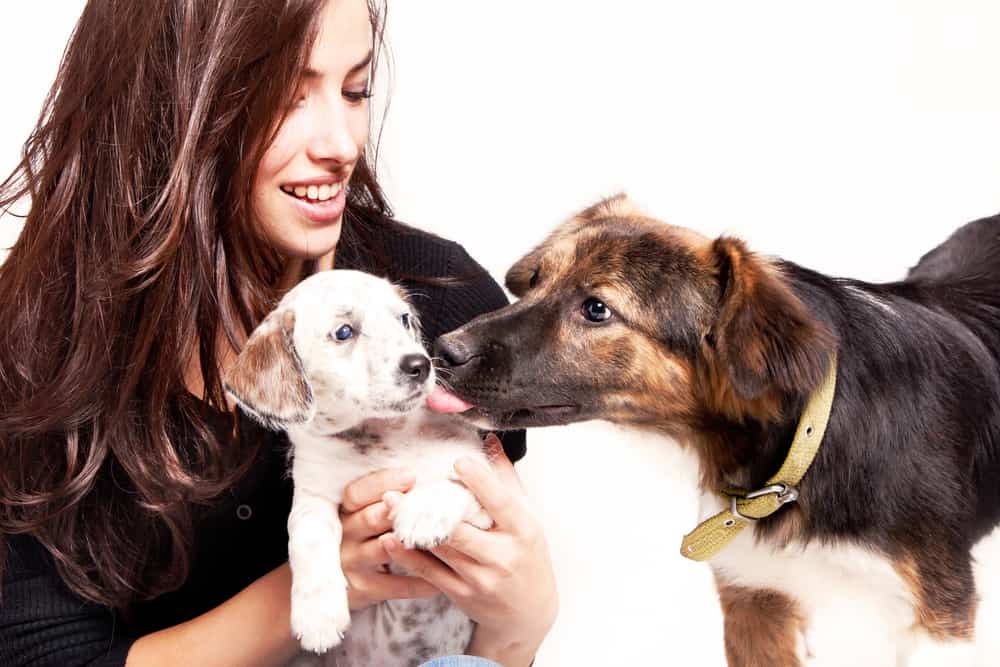



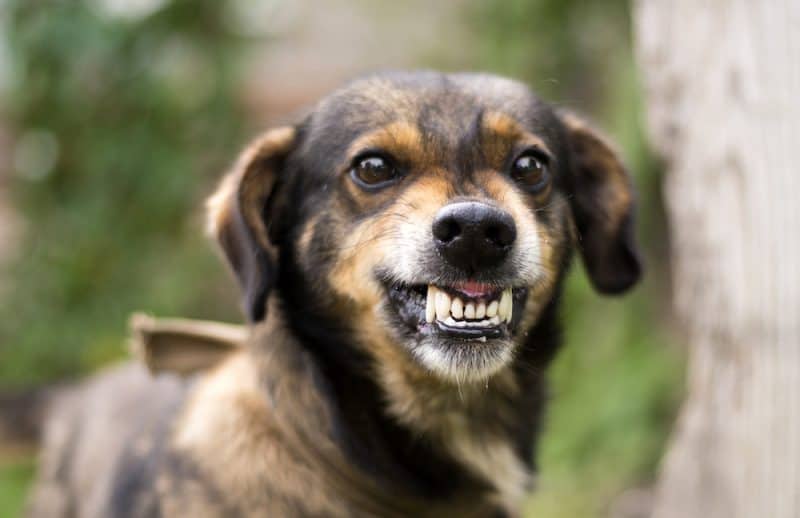
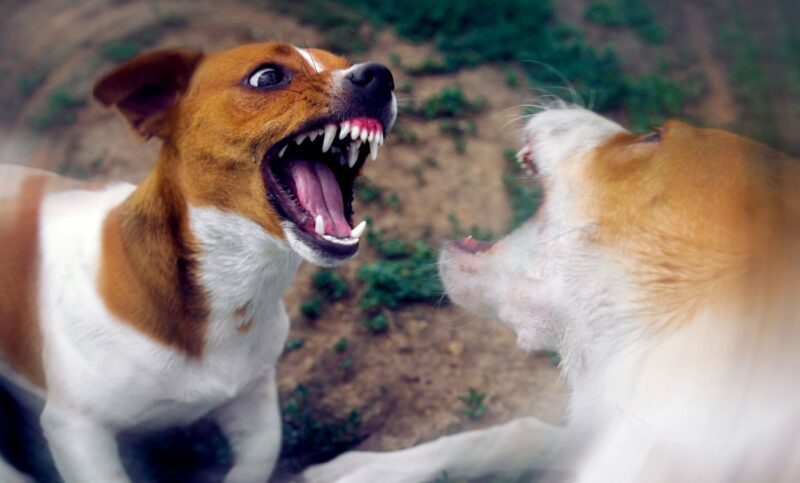
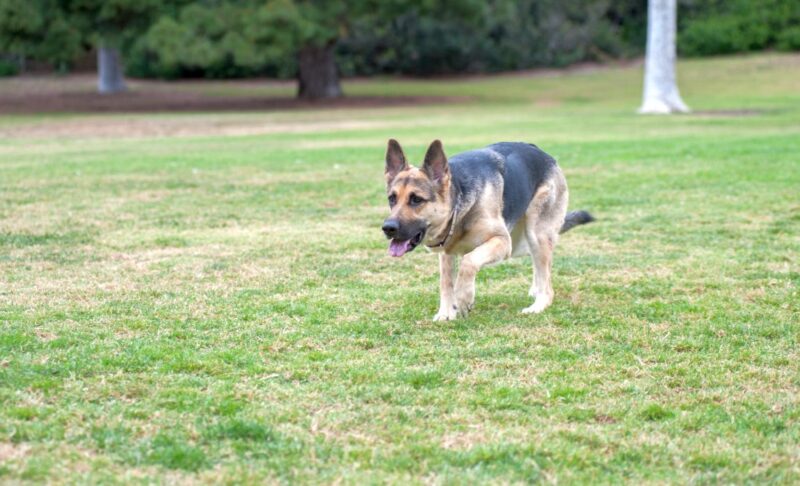

Leave a Comment